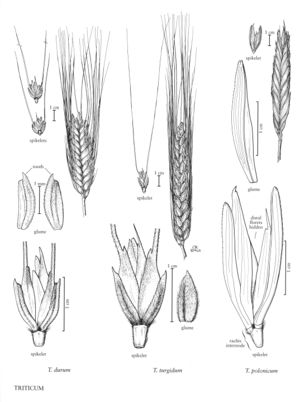Triticum durum
Culms 60-160 cm; nodes glabrous; internodes mostly hollow, solid for 1 cm below the spikes. Blades 7-16 mm wide, usually glabrous. Spikes 4-11 cm, about as wide as thick, never branched; rachises ciliate to partially ciliate at the nodes and margins, not disarticulating; internodes 3-6 mm. Spikelets 10-15 mm, with 5-7 florets, 2-4 seed-forming. Glumes 8-12 mm, coriaceous, loosely appressed to the lower florets, with 1 prominent keel, terminating in a tooth, tooth to 0.3 cm; lemmas 10-12 mm, lower 2 lemmas awned, awns to 23 cm; paleas not splitting at maturity. Endosperm usually flinty, sometimes mealy. Haplomes AuB. 2n = 28.
Distribution
Alta., Man., Sask.
Discussion
Triticum durum is a domesticated spring wheat that is grown in temperate climates throughout the world. In the Flora region, it is grown in the Canadian prairies and northern Great Plains as a spring wheat, and in the southwestern United States and Mexico as a winter wheat. Triticum durum is typically used for macaroni-type pastas, semolina, and bulghur. Durum imparts a yellowish color to bread, and is the traditional wheat for flat breads and pita. Cultivars grown in the Flora region represent a minor sampling of the overall diversity in the species.
The commercial cultivar Kamut® is durum wheat. Grown in the Flora region and worldwide, it encompasses a variable collection of forms. Kamut® has also been identified as Triticum turanicum Jakubz. (a durum-like wheat from Iran) or T. polonicum, although its presumed Egyptian origin and spike morphology do not agree with the original concept of these species.
Selected References
None.
Lower Taxa
"decumbent" is not a number."-3timesthelengthof" is not declared as a valid unit of measurement for this property.
